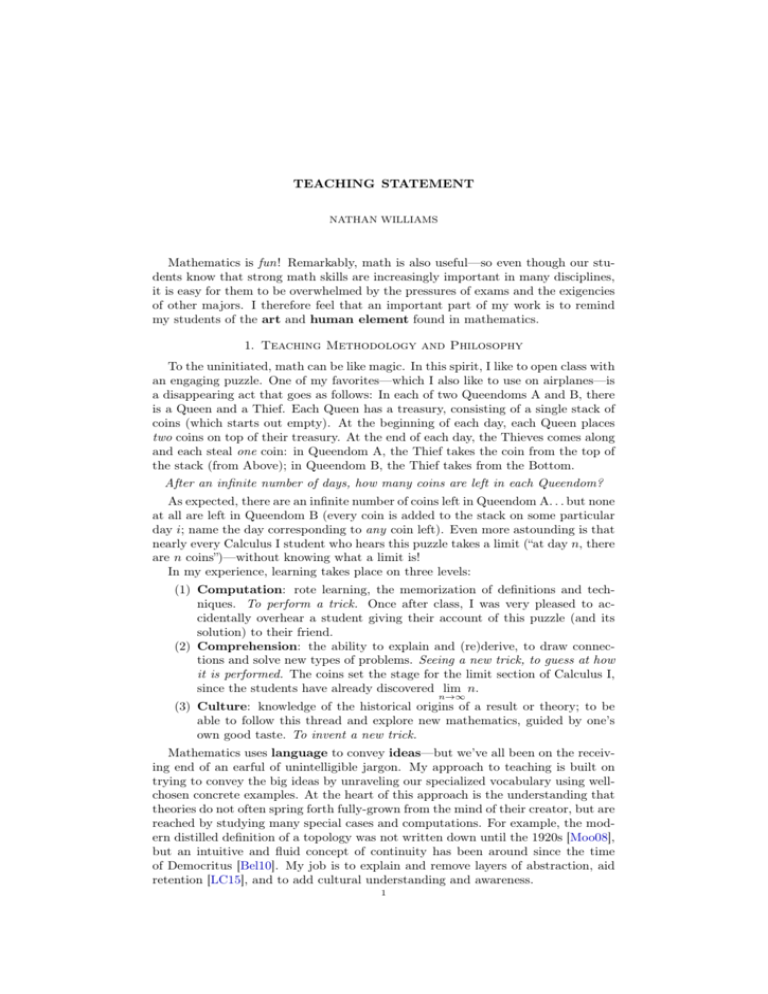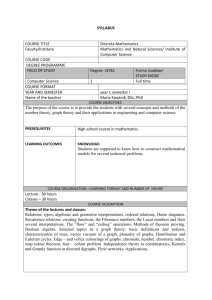Teaching Statement - LaCIM
advertisement

TEACHING STATEMENT NATHAN WILLIAMS Mathematics is fun! Remarkably, math is also useful—so even though our students know that strong math skills are increasingly important in many disciplines, it is easy for them to be overwhelmed by the pressures of exams and the exigencies of other majors. I therefore feel that an important part of my work is to remind my students of the art and human element found in mathematics. 1. Teaching Methodology and Philosophy To the uninitiated, math can be like magic. In this spirit, I like to open class with an engaging puzzle. One of my favorites—which I also like to use on airplanes—is a disappearing act that goes as follows: In each of two Queendoms A and B, there is a Queen and a Thief. Each Queen has a treasury, consisting of a single stack of coins (which starts out empty). At the beginning of each day, each Queen places two coins on top of their treasury. At the end of each day, the Thieves comes along and each steal one coin: in Queendom A, the Thief takes the coin from the top of the stack (from Above); in Queendom B, the Thief takes from the Bottom. After an infinite number of days, how many coins are left in each Queendom? As expected, there are an infinite number of coins left in Queendom A. . . but none at all are left in Queendom B (every coin is added to the stack on some particular day i; name the day corresponding to any coin left). Even more astounding is that nearly every Calculus I student who hears this puzzle takes a limit (“at day n, there are n coins”)—without knowing what a limit is! In my experience, learning takes place on three levels: (1) Computation: rote learning, the memorization of definitions and techniques. To perform a trick. Once after class, I was very pleased to accidentally overhear a student giving their account of this puzzle (and its solution) to their friend. (2) Comprehension: the ability to explain and (re)derive, to draw connections and solve new types of problems. Seeing a new trick, to guess at how it is performed. The coins set the stage for the limit section of Calculus I, since the students have already discovered lim n. n→∞ (3) Culture: knowledge of the historical origins of a result or theory; to be able to follow this thread and explore new mathematics, guided by one’s own good taste. To invent a new trick. Mathematics uses language to convey ideas—but we’ve all been on the receiving end of an earful of unintelligible jargon. My approach to teaching is built on trying to convey the big ideas by unraveling our specialized vocabulary using wellchosen concrete examples. At the heart of this approach is the understanding that theories do not often spring forth fully-grown from the mind of their creator, but are reached by studying many special cases and computations. For example, the modern distilled definition of a topology was not written down until the 1920s [Moo08], but an intuitive and fluid concept of continuity has been around since the time of Democritus [Bel10]. My job is to explain and remove layers of abstraction, aid retention [LC15], and to add cultural understanding and awareness. 1 2 N. WILLIAMS 2. Teaching Experience I have five years of experience as a teaching assistant at the University of Minnesota, during which my reviews were overwhelmingly positive. During that time, I had several rewarding experiences where former students—from my courses the previous semester—would come to my new office hours for help in their current math classes; several students ultimately asked me for letters of recommendation. I served as lecturer for three weeks (8 lectures) in the course “Excursions in Mathematics”—a roller-coaster of a course that covered everything from voting theory and fair division to graph theory and compound interest. Capitalizing on the immediate algorithmic relevancy of the material, I found that breaking the class into small problem-solving groups maximized their engagement: “mathematics is not a spectator sport!” The following anecdote best encapsulates this memorable experience for me: a diligent, but struggling, student who who succeeded in eeking out a C+ as her final grade sent me a warm, heartfelt message detailing her struggles in math classes (since 7th grade), as well as how much she learned in our course and how hard she would continue to work towards her degree. I applied to become a teaching assistant for the then-newly-formed Masters in Financial Mathematics (MFM) program at the University of Minnesota, for which I prepared type-written solutions and notes. Most of these students were working professionals, some of whom were taking the course remotely; my office hours were necessarily offered in the evenings, as well as online and by phone to accommodate them. It was a pleasure to follow the progress of these mature and motivated students through their first year. Though my postdoctoral position at the Université de Québec à Montréal was research-oriented, I sought out opportunities to evolve in my teaching by giving several short lecture series on topics in algebraic combinatorics in Graduate Research Seminars and in the annual summer school. The topics were more advanced (reflection groups), but I maintained my emphasis of presenting general theory using specific hands-on examples. For example, Weyl’s formula relating the size of a Weyl group and a parallelepiped became the following animation for the symmetric group S4 . 3. Mentoring Experience Because of its many elementary problems, combinatorics is a discipline in which undergraduate students can immediately become involved in research-level mathematics. In 2014, I mentored Stephanie Schanack, Fatiha Djermane, and Sarah Ouahib on an original research problem involving the characterization of the fixed points of a certain combinatorial set under a cyclic group action. After covering the basics of experimental mathematics using Sage and typesetting using LATEX, I guided them through an intricate network of case-by-case analysis. The three wrote up their proof in a beautiful report available online [SSD14]. In 2011, I provided computational support to David B Rush and XiaoLin Shi [RS13], who developed a wonderful generalization of my work in [SW12]. At the 2010 combinatorics REU at the University of Minnesota, I suggested certain partition identities to Gaku Liu, then an undergraduate at Princeton [Liu10]. I also helped a second group formulate and computationally test conjectures on a combinatorial reformulation of the four-color theorem [CSS14]. TEACHING STATEMENT 3 References [Bel10] John L Bell, Continuity and infinitesimals, continuity and infinitesimals, 2010. 1 [CSS14] Sebastian A Csar, Rik Sengupta, and Warut Suksompong, On a subposet of the Tamari lattice, Order 31 (2014), no. 3, 337–363. 2 [LC15] Siew Yee Lim and Elaine Chapman, Effects of using history as a tool to teach mathematics on students’ attitudes, anxiety, motivation and achievement in grade 11 classrooms, Educational Studies in Mathematics 90 (2015), no. 2, 189–212. 1 [Liu10] Gaku Liu, A few approaches to solving the Borwein conjecture. 2 [Moo08] Gregory H Moore, The emergence of open sets, closed sets, and limit points in analysis and topology, Historia Mathematica 35 (2008), no. 3, 220–241. 1 [RS13] David B Rush and XiaoLin Shi, On orbits of order ideals of minuscule posets, Journal of Algebraic Combinatorics 37 (2013), no. 3, 545–569. 2 [SSD14] Stéphanie Schank, Sarah Sekheri, and Fatiha Djermane, Un CSP sur des tableaux décalés en forme d’escalier, http://lacim.uqam.ca/rapports_pdf/ SekheriSchankDjermane2014.pdf, 2014. 2 [SW12] Jessica Striker and Nathan Williams, Promotion and rowmotion, European Journal of Combinatorics 33 (2012), no. 8, 1919–1942. 2 (N. Williams) LaCIM, Université du Québec à Montréal, Montréal (Québec), Canada E-mail address: nathan.f.williams@gmail.com






